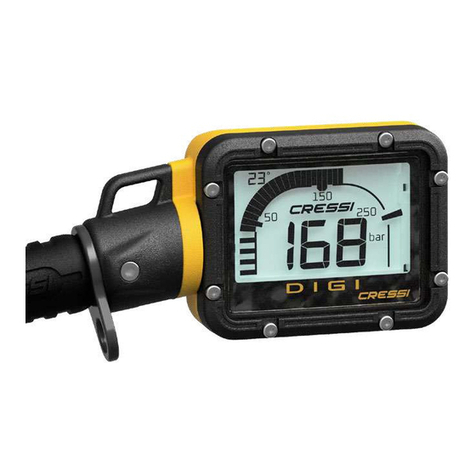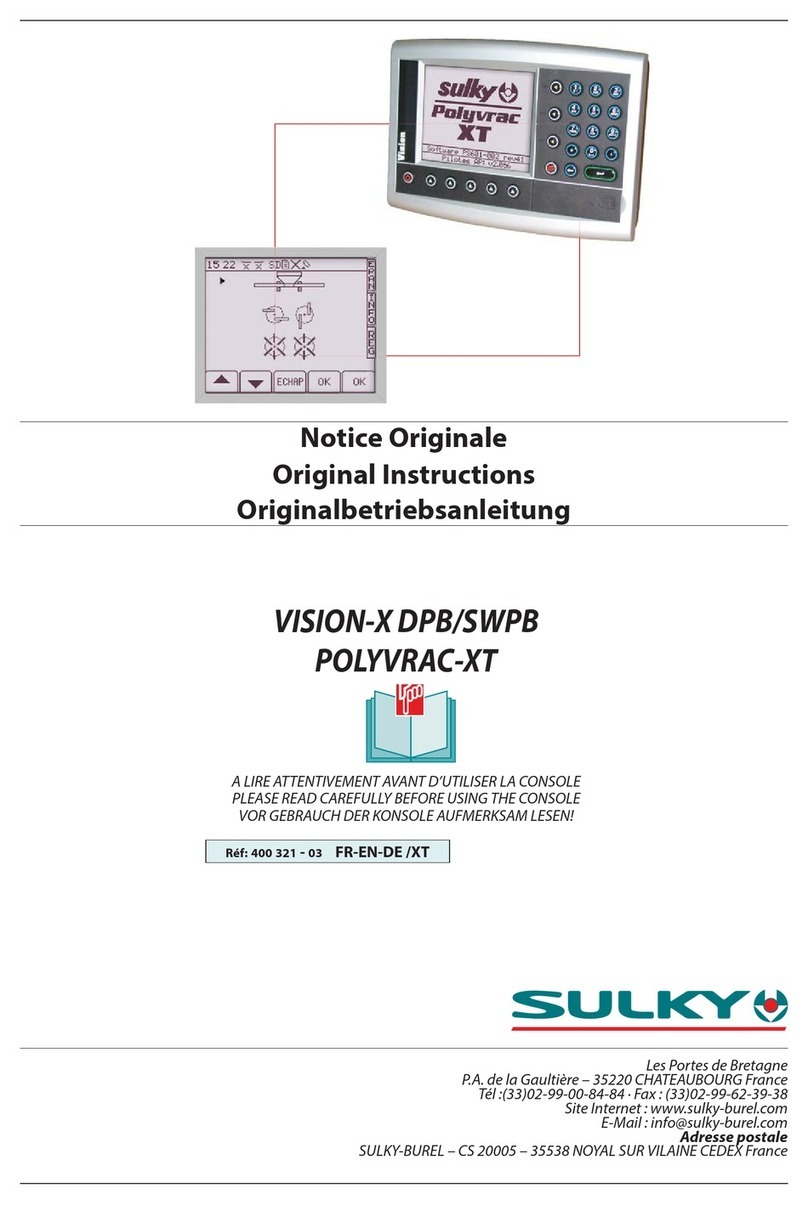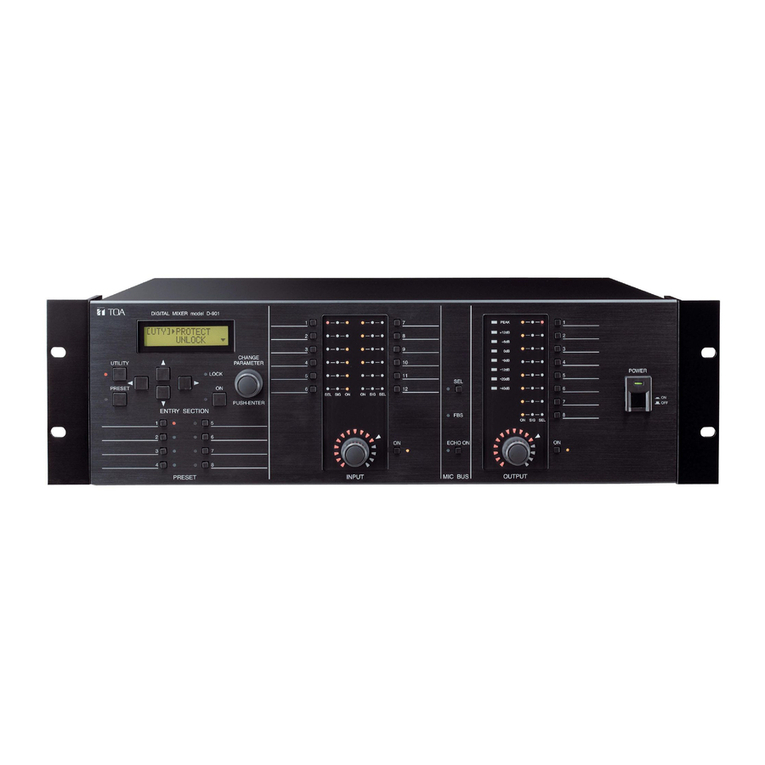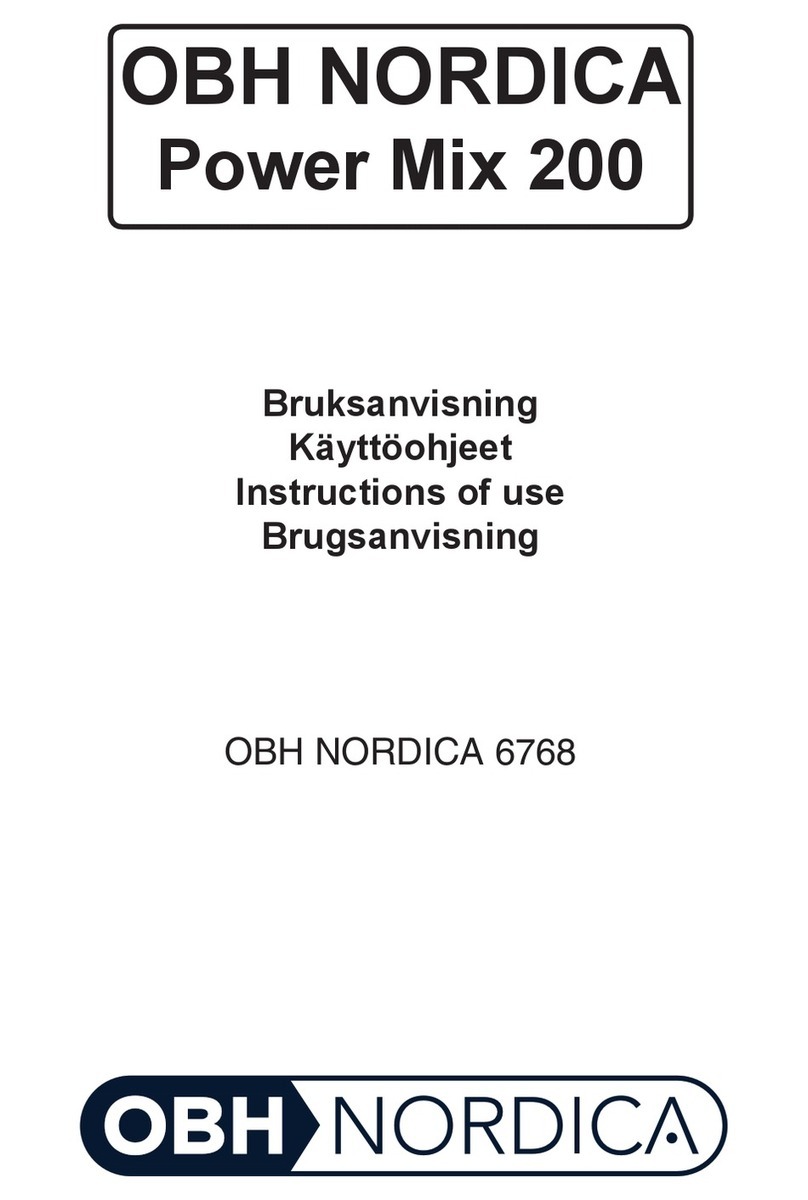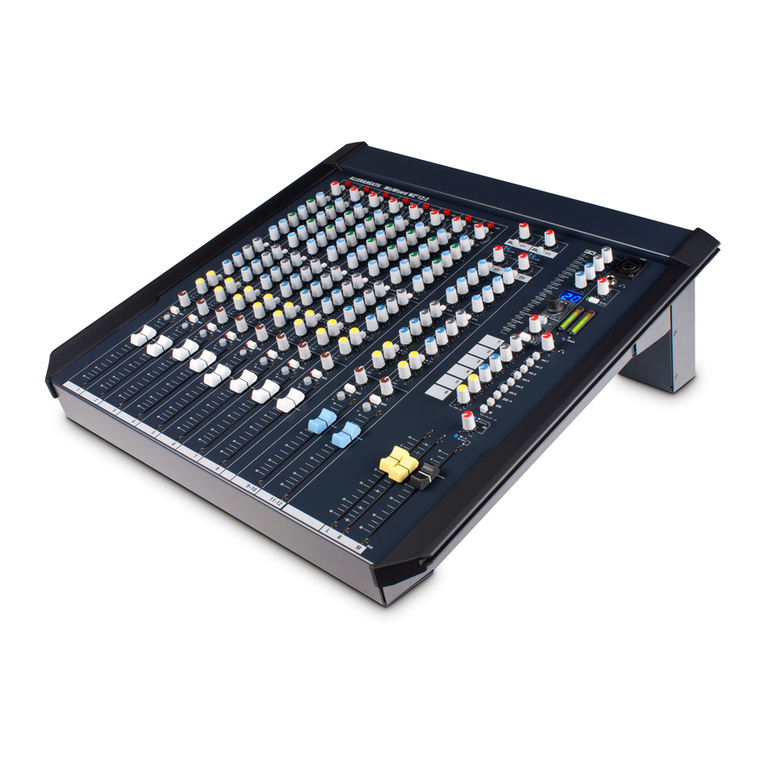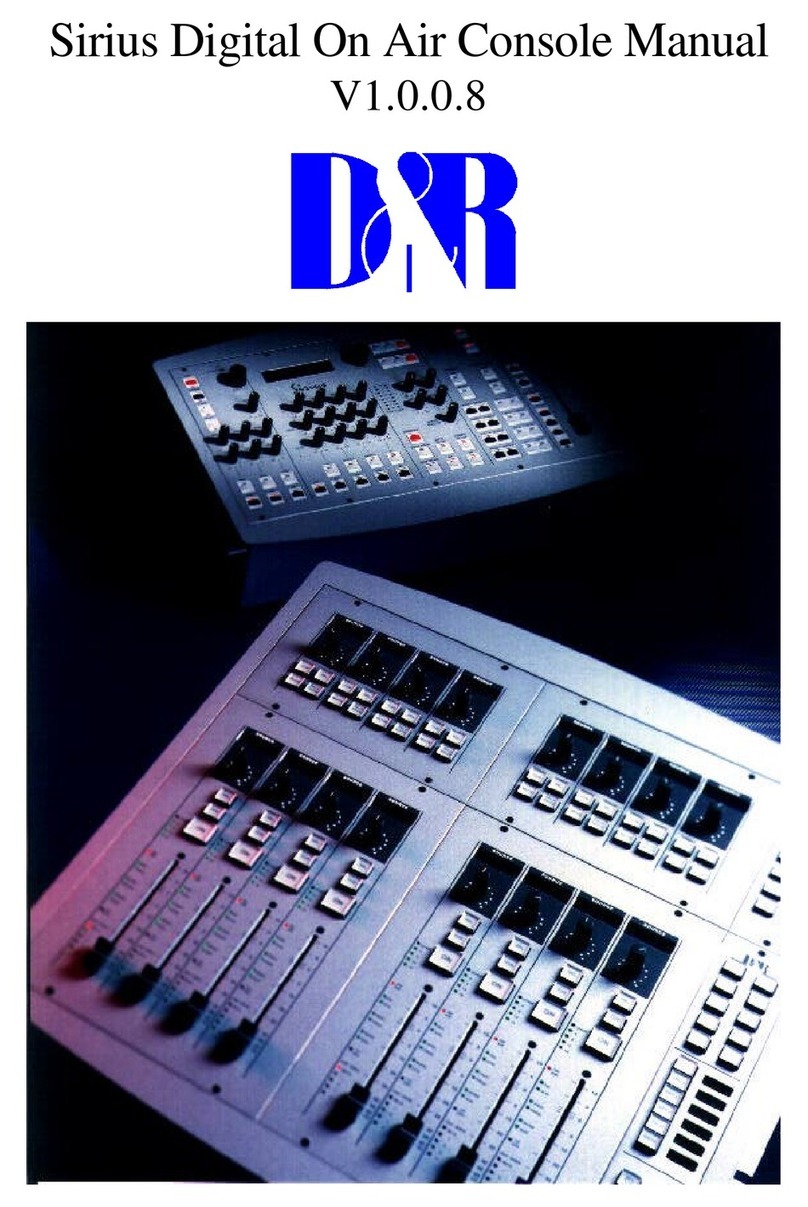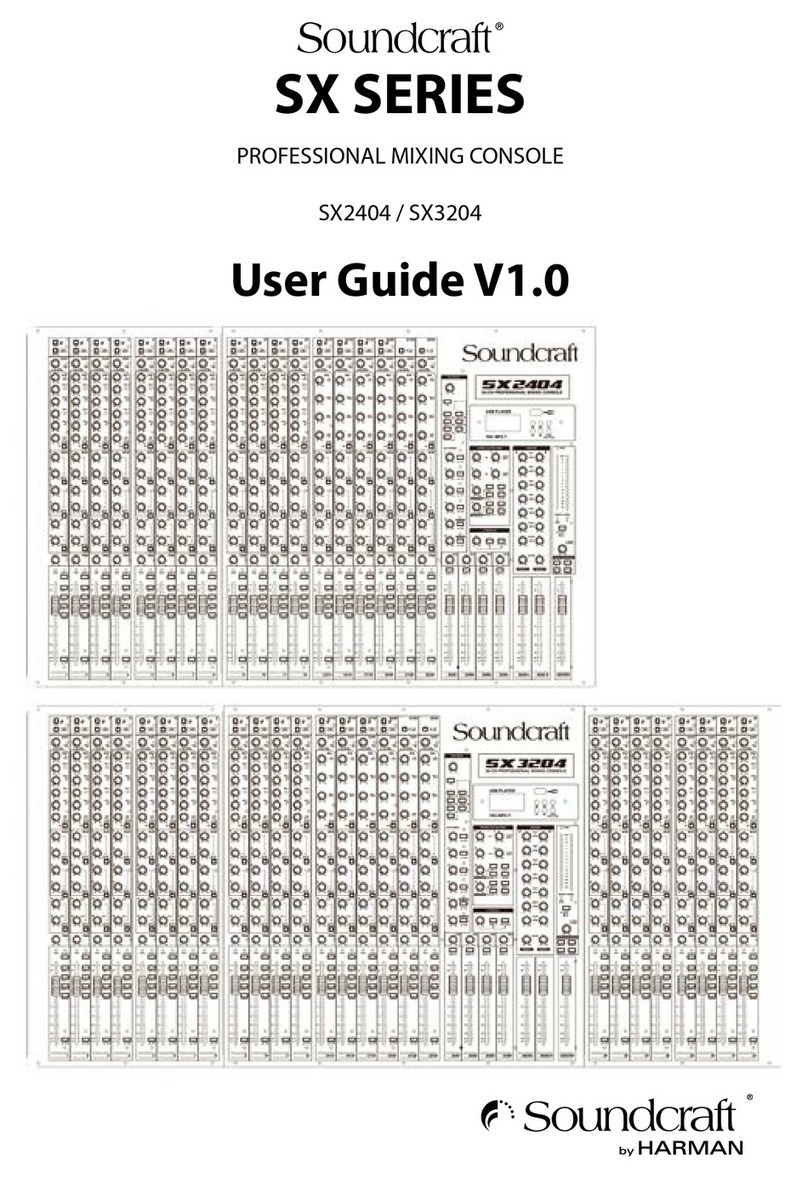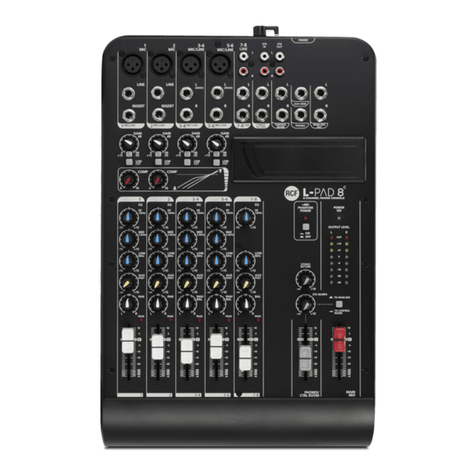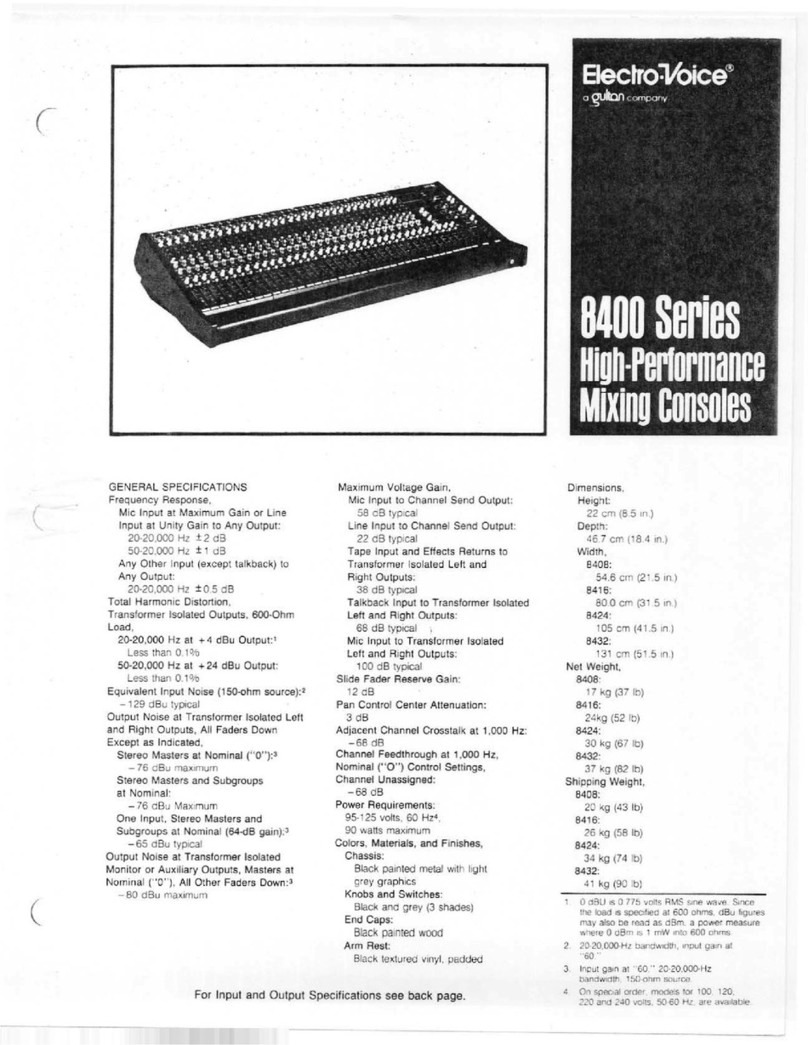Stemin MX12 User manual

MX12
USER INSTRUCTIONS
..........................
3
8
Please read the manual before using the equipment!

40 MX12
Table of Contents
1
Safety and Environment........................................................................................... 41
Safety ........................................................................................................................ 41
Environment .............................................................................................................. 41
2
Description ............................................................................................................... 42
Introduction ............................................................................................................... 42
Scope of supply ......................................................................................................... 42
Optional Accessories .................................................................................................. 42
Summary ................................................................................................................... 42
Front panel ................................................................................................................ 4
Rear panel ................................................................................................................. 44
Automix algorithm ...................................................................................................... 48
3
Installation and Connection ..................................................................................... 49
Rack mounting ........................................................................................................... 49
Cascading ................................................................................................................. 49
Connecting microphones and accessories ................................................................... 50
Mains connection ....................................................................................................... 50
4
Operation ................................................................................................................. 51
Control concept .......................................................................................................... 51
Configuring MX12 ...................................................................................................... 51
MX12 operation ......................................................................................................... 51
DSP functions ............................................................................................................ 54
5
Cleaning ................................................................................................................... 7
6
Specifications .......................................................................................................... 77
General ..................................................................................................................... 77
Power supply unit ....................................................................................................... 77
Inputs ........................................................................................................................ 77
Outputs ..................................................................................................................... 77
7
Troubleshooting ....................................................................................................... 78
FCC statement
This equipment has been tested and found to comply with the limits for a Class B digital device, pursuant to Part 15 of the
FCC Rules. These limits are designed to provide reasonable protection against harmful interference in a residential installation.
This equipment generates, uses, and can radiate radio frequency energy and, if not installed and used in accordance with the
instructions, may cause harmful interference to radio communications. However, there is no guarantee that interference will
not occur in a particular installation. If this equipment does cause harmful interference to radio or television reception, which
can be determined by turning the equipment off and on, the user is encouraged to try to correct the interference by one or
more of the following measures:
•Reorient or relocate the receiving antenna.
•Increase the separation between the equipment and the receiver.
•Connect the equipment to an outlet on a circuit different from that to which the receiver is connected.
•Consult the dealer or an experienced radio/TV technician for help.
Shielded cables and I/O cords must be used for this equipment to comply with the relevant FCC regulations. Changes or
modifications not expressly approved in writing by STEMIN GMBH may void the user’s authority to operate this equipment.
This device complies with Part 15 of the FCC Rules. Operation is subject to the following two conditions: (1) this device may
not cause harmful interference, and (2) this device must accept any interference received, including interference that may
cause undesired operation.
Table of Contents

MX12 41
Safety and Environment
•Do not expose the unit to direct sunlight, excessive dust or moisture, rain, vibrations or
shocks.
•Do not spill any liquids on the unit or drop any objects through the vents into the unit.
•The unit may be used in dry rooms only.
•The unit may be opened, serviced and repaired by authorised personnel only. The unit
contains no user-serviceable parts.
•Before starting up the unit, check that the operating voltage indicated on the unit is the
same as the mains voltage where you will be using the unit.
•Only operate the unit with a mains voltage of between 90 and 240 V AC. Other types of
current and voltages may cause serious damage to the unit!
•Immediately disconnect the unit if a solid object or liquid enters the interior of the unit. In
this case, immediately disconnect the power cord of the power supply unit from the socket
and have the unit checked by our customer service personnel.
•Do not place the unit close to heat sources such as radiators, heating ducts or amplifiers,
etc. and do not expose it to direct sunlight, excessive dust or moisture, rain, vibrations or
shocks.
•To avoid interference, position all cables, in particular those of the microphone inputs,
away from power lines. If cables are to be installed in channels or cable ducts, be sure to
place the transmission lines in a separate duct.
•Clean the unit with a moistened (not wet) cloth only. Before doing so, it is essential to
unplug the unit's power cord from the socket! Never use caustic or scouring cleaners or
cleaning agents containing alcohol or solvents, since these may damage the enamel and
plastic parts.
•Use the unit only for the purposes described in these operating instructions. STEMIN GMBH
will accept no liability for damage caused by incorrect handling or improper use.
•When the product reaches the end of its life, separate the housing, electronics and cables
and dispose of all components in accordance with local waste disposal regulations.
•The packaging can be recycled. Dispose of the packaging in a suitable collection system.
1Safety and Environment
Safety
Environment

42 MX12
Description
Thank you for purchasing an STEMIN GMBH product. This Manual contains important
instructions for setting up and operating your equipment. Please take a few minutes to read
the instructions below carefully before operating the equipment. Please keep the Manual
for future reference. Have fun and impress your audience!
Please check that the packaging contains all the components. If anything is missing, please
contact your STEMIN GMBH dealer.
•1 x MX12
•1 x Quick Setup Guide
For optional accessories, refer to the current STEMIN GMBH catalog or folder, or visit
www.Stemin.com. Your dealer will be glad to help.
The MX12 is a 19" automatic microphone mixer. Internal signal processing takes place
digitally and on five master buses (stereo). The inputs and outputs are analogue, with the
exception of the digital outputs.
It also has twelve balanced inputs, which can be configured as microphone inputs or line
inputs (e.g. for wireless microphone receivers).
On the output side it has two balanced stereo master output channels, one stereo recording
output, one digital output and one stereo headphone output.
Inputs and outputs are controlled by the rotary knobs and circular LED displays on the front
panel. The device has a wide-range power supply unit and is connected to the mains using
the mains cable supplied.
In addition to many digital signal processing functions, the MX12 also has innovative
automatic mixing functions.
Up to ten MX12 can be cascaded if the twelve balanced inputs are not sufficient for your
application.
2Description
Introduction
Scope of suppl
y
Optional Accessories
Summary

MX12 4
Description
There are 16 rotary knobs on the front panel.
Figure 1: Front panel of the MX12
1 - 12: Microphone or line inputs
1 : Operating mode / system control
14, 16: Stereo outputs 1 and 2
15, 17: Control display for stereo outputs 1 and 2
18: Headphone output
19: Headphone connection
The rotary knobs can be used to adjust the parameters of the selected audio function.
Each input channel has a green "ON" LED and a red "PEAK" LED. "ON" lights up when the
input channel is connected. "ON" remains illuminated if the automix function is switched off.
"PEAK" lights up when the signal on an input channel is close to the maximum control limit. In
this case, the level should be turned down or the input sensitivity should be changed.
NOTE
Due to the clarity, the active blue LED's of the knob of the auto mixer in the
owner's manual instructions are shown in yellow color.
NOTE
The input sensitivity is adjusted using the gain control on the rear panel of the connected unit.
NOTE
MUTE function:
Briefly pressing a rotary knob causes the corresponding channel to be muted. The MUTE
function is indicated by the steady flashing of the LED rings. Another brief press of the rotary
knob removes the MUTE function.
VU function:
The "SYSTEM CONTROL" rotary knob can be used to display the current audio level of the
inputs, see MX12 operation.
Inputs
The MX12 has 12 balanced input channels for connecting low-impedance dynamic or
condenser microphones and other audio sources, e.g. receivers for wireless microphones. A
rotary knob is available for each input channel. These are labelled "IN 1" to "IN 12".
Operatin mode / system control
The MX12 has a large number of functions, such as volume, treble ranges, bass, auto-mix
functions, etc. The "SYSTEM CONTROL" rotary knob can be used to select these functions.
Stereo outputs
The rotary knobs for the stereo output channels are labelled "OUT 1" and "OUT 2". These
rotary knobs adjust the volume, treble and bass range, limiting behaviour, balance and delay
in the output channels.
Control display for stereo outputs
The control displays under the rotary knob for the stereo output channels indicate the output
level in dB.
Front panel

44 MX12
Description
Stereo headphone output
Both the inputs and outputs can be monitored on the stereo headphone output. Hold down the
"HEADPHONE" rotary knob and select another monitor source by pressing another rotary
knob. You can monitor several sources with inputs. In mono, they are simultaneously switched
to the left and right headphone channel. The output can only monitor individual sources, but in
stereo. The previous monitoring source is switched off by pressing on another source (switch
between inputs and output). The output "REC (OUT)" cannot be monitored.
Figure 2: Rear panel of the MX12
1: Input channels 1-12
2: Gain control 1-12
: Phantom power for two input channels
4a, 4b: Output channel 1, stereo left, right
5a, 5b: Output channel 2, stereo left, right
6: Stereo record output
7: Expansion connectors
8: Serial control (RS2 2)
9: Phoenix terminal (grounding / remote control)
10: Mains switch
11: Mains connection
12: Digital output
Input channels
Figure 3: Input channels
The 12 balanced input channels can be accessed via pin phoenix sockets. These are
labelled "IN 1" to "IN 12". The input levels can be controlled with the rotary knobs "IN 1" to
"IN 12" on the front panel.
A switch for the phantom power and a gain control for every channel is located between two
phoenix sockets.
Gain control
Figure 4: Gain control
The associated gain control is located next to every input channel, with integrated switch for
the left stop, to set the input level. The input level is set at 0 dB when the left end stop is
reached. By turning the control clockwise the gain can be increased by max. 57 dB.
Rear panel

MX12 45
Description
Phantom power
Figure 5: PHA TOM POWER slide switch
The slide switches activate the phantom power supply of +48 V for the input channels located
on the left or right. The slide switch is labelled with "PHANT. PWR". Two input channels are
always activated simultaneously. The phantom power is activated when the slide switch is in
the "On" position.
Output channels
Figure 6: Stereo output channel
The device has two balanced stereo master output channels. It can be accessed via two pin
phoenix sockets. The outputs are labelled "OUT 1/L" and "OUT 1/R" or "OUT 2/L" and "OUT
2/R". The "OUT 1" or "OUT 2" rotary knobs on the front are used to adjust the output level
settings for the stereo output channel.
The allocation of the individual channels to the balanced master outputs can be configured as
desired.
Stereo record output
Figure 7: Recording output
Two RCA jacks, labelled "REC (OUT)", are available for connecting stereo recording
equipment. The allocation of the individual channels to the asymmetrical stereo recording
output can be configured as desired.
Expansion/cascadin connections
Figure 8: EXPA SIO
Two RJ-45 sockets are provided for expansion/cascading. These are labelled with "IN -
EXPANSION - OUT".

46 MX12
Description
Serial control
NOTE
This connection is for use by authorised specialist staff only!
Standard: RS-2 2
Use: connect to PC, firmware update, external control
Figure 9: RS232 socket
The serial control takes place using a 9 pin sub-D socket with the label "RS2 2". This socket
allows you to perform software updates.
The pin assignment is as follows:
Pin
Function
1 N.C.
2 RxD
TxD
4 N.C.
5 GND
6 GND
7 N.C.
8 N.C.
9 N.C.
Earth/Ground connection
Figure 10: Phoenix terminal
A phoenix terminal connects the case with the 0 V potential of the power supply.
NOTE
Only bridge the 0 V potential with the grounding (factory setting) or connect it to the central
system ground, as otherwise the phantom power has no reference point and will not function.

MX12 47
Description
Analo ue control
Figure 11: Phoenix terminal
A linear 50 kOhm potentiometer at the VCA input, labelled "VCA" and "⊥", allows you to vary
the master volume.
Figure 12: VCA
The linear potentiometer is connected to the VCA input as shown above. The resistance at the
VCA input is changed by turning the potentiometer. This value is input and the volume is
changed accordingly. The left setting signifies 0% while the right setting signifies 100%.
The output level depends on the master control and the remote level control. The remote level
control has the same affect on both masters.
Di ital output
Figure 13: Digital output
The MX12 has a digital output which can be picked up via a balanced AES/EBU or an optical
S/PDIF output on the rear panel of the device. The AES/EBU output can be accessed via a
pin Phoenix terminal. The assignment from left to right is a, b, shield. The optical output is
accessible via a TOSLINK socket.
Both digital outputs have the same data signal. The signal is in stereo, has a 24 Bit data
format and a sample frequency of 48 kHz.
The "ROUTING TO DIGOUT" function on the system control on the front panel can be used to
individually or jointly route the inputs.
Power switch
The power switch is used to turn on the unit.

48 MX12
Description
The unit's automix algorithm has basic functions which assess the amount by which an
input signal is to be attenuated and the output signal's output level. The following functions
and parameters flow into the automix algorithm:
Dynamic level adjustment
The master of all input channels is determined on an ongoing basis. This value is used as the
reference value. If the input channel level is very close or over the reference value, this
channel will be assessed as dominant and will be slightly attenuated. If the input channel level
is well below the reference value, this is assessed as ambient noise and be severely
attenuated.
A channel's output level is calculated using the following formula:
Output level = Input level - (Reference value - Input level)
This formula ensures that the output level will not become louder if several input channels are
active, rather the master assumes the level of a single channel. This reduces the risk of
feedback.
If a channel is no longer assessed as dominant, this falls at 1 dB/second and all other non-
dominant channels increase with the same constant so that the master output level remains
constant. The upward adjustment of a channel takes between ms and 5 ms.
Best Mic On
With two microphones that are positioned close together there is the disadvantage that comb
filter effects may arise by cancelling the frequency components. To suppress these unnaturally
muffled or hollow signals, only the microphone channel with the highest level is assessed as
dominant and switched on.
Noise Detect
Permanently present interfering signals, whose amplitude are large enough to be assessed as
dominant, but whose level and frequency changes are too low, are not assessed as dominant.
Interfering signals such as noise from fans and air-conditioning units are recognised and not
used as activation criteria for microphone channels.
Automix al orithm

MX12 49
Installation and Connection
Mount the MX12 in your 19" rack.
NOTE
We recommend only using STEMIN GMBH accessory cables for cascading.
The unit has two 100 MBit/s ethernet interfaces. These communicate the control data and
audio between up to 10 units. This allows an automix system with up to 120 input channels,
40 output channels and 10 stereo headphone outputs to be established.
The master buses for "OUT 1", "OUT 2", "REC-OUT", "DIGOUT" and "HEADPHONE" are
accessible for all of the cascaded units across the entire system. Every unit adds its input
channels to the master buses, which are transferred via the ethernet interface. Every unit can
monitor and output the master buses.
The automix algorithm also transfers its control data via this interface. This allows the automix
algorithm to function system-wide.
The individual units must be connected to the expansion connectors as follows:
Figure 14: daisy-chaining multiple units
ATTENTION
Do not connect the first cascade unit with the last unit.
For the user, the function and behaviour of all the units are the same. All of the cascaded units
retain their individual functions. A standard CAT5+ connection cable can be used.
The available "SYSTEM CONTROL" functions associated with cascading are described in the
section Cascaded device operation.
3Installation and Connection
Rack mountin
Cascadin

50 MX12
Installation and Connection
NOTE
Before connecting, read the operating instructions for your microphones and accessories.
Connect microphones and accessories to the back of the MX12:
1) Connect microphones and other signal sources (e.g. wireless microphone receivers) to
the "IN" input channels.
2) Connect the "OUT - L" and "OUT - R" output channels to a mixing desk or amplifier.
) Connect the RCA jacks on the stereo recording output "REC (OUT)" to a recording device.
ATTENTION
Do not connect the unit to the mains power supply until you have established all the audio
connections!
1) Connect the mains power supply cable to the appropriate socket on the rear panel of the
MX12.
2) Plug the power supply cable into a mains socket.
Connectin microphones and accessories
Mains connection

MX12 51
Operation
There are 16 rotary knobs on the front panel. These are labelled "IN 1" to "IN 12", "SYSTEM
CONTROL", "OUT 1", "OUT 2" and "HEADPHONE".
The rotary knobs on the inputs are each surrounded by an LED ring with 15 yellow LEDs, one
green LED and one red LED. The rotary knob "SYSTEM CONTROL" and the rotary knobs on
the outputs are surrounded by 15 yellow LEDs. The control display under the outputs has 6
green, one yellow and one red LED.
The LED rings help to visualise the rotary knob setting or display signal levels.
NOTE
Please read the instructions for connecting your microphones and auxiliary equipment under
Installation and Connection
Installation and ConnectionInstallation and Connection
Installation and Connection (Page 49).
Configure the connected microphones and auxiliary equipment using the slide switches and
the gain controls on the rear panel of the MX12:
1) If you use condenser microphones, check what supply voltage or what type of power
supply they require. Switch on the phantom power if your condenser microphones are
suitable for phantom power. To do so, set the "PHANT. PWR" slide switch to "ON".
ATTENTION
Risk of damage
If you are using wireless microphones, it is essential to switch off the phantom power on those
inputs to which you have connected a receiver in order to avoid damaging the receiver.
2) For the gain of the input signals, choose between 0 dB and +57 dB. Use the respective
gain control to do so.
NOTE
A higher gain of the input signals is suitable for microphones with lower output levels.
A lower gain is recommended for microphones with a high output level.
) Turn the unit on at the power switch.
The rotary knobs on the front panel of the MX12 are operated as follows:
Figure 15: Operation of the rotary knob
Turn the rotary knob clockwise or counter-clockwise to make changes to inputs and outputs
and function settings. These changes are shown on the LED ring around the rotary knob. The
starting point and the increments on the LED ring will vary according to the function.
4Operation
Control concept
Confi urin
MX12
MX12
operation

52 MX12
Operation
Audio level display / VU function:
NOTE
If the LEVEL function is selected, the set level is displayed on the LED rings of the inputs and
outputs.
Briefly pressing the "SYSTEM CONTROL" rotary control switches the display on the LED rings
to VU meter, the display of the actual audio level present. As long as the VU meter mode is
activated, the LEVEL LED flashes on the "SYSTEM CONTROL" rotary control. Pressing the
"SYSTEM CONTROL" rotary control again deactivates the VU meter mode.
System control
Figure 16: SYSTEM CO TROL rotary knob
To adjust the unit parameters, select the desired mode on the "SYSTEM CONTROL" rotary
knob.
1) Select the function you require using the "SYSTEM CONTROL" rotary knob. Turn the
rotary knob until the LED for the required function lights up.
2) Control the input channels by using the function selected with the rotary knobs "IN 1" to
"IN 12".
) Control the output channels by using the function selected with the rotary knobs "OUT 1"
to "OUT 2".
4) Control the headphone stereo output channel using the "HEADPHONE" rotary knob.
The stereo recording output and the digital output have no setting options.
NOTE
The "SYSTEM CONTROL" rotary knob returns to the "LEVEL" function five minutes after the last
change. The set value is automatically stored one minute after the last change.
The following functions can be selected:
•Level
•Treble
•Bass
•Low Cut
•Limiter
•Compressor
•Automixing
•Priority
•Pan / Balance
•Delay
•Routing to OUT 1
•Routing to OUT 2
•Routing to REC
•Routing to DIGOUT
•Equalizer

MX12 5
Operation
Input channel modes
The input channels have the following function controls:
•Level
•Treble
•Bass
•Low Cut
•Compressor
•Automixing
•Priority
•Pan
•Routing to OUT 1
•Routing to OUT 2
•Routing to REC
•Routing to DIGOUT
•Monitoring
•Mute
Output channel modes
The output channels have the following function controls:
•Level
•Treble
•Bass
•Limiter
•Balance
•Delay
•Equalizer
•Monitoring
•Mute
Stereo headphone output modes (output for monitorin )
The "HEADPHONE" rotary knob is an exception. The stereo headphone output is always
located in the "LEVEL" mode, regardless of the "SYSTEM CONTROL" rotary knob setting.

54 MX12
Operation
The following signal processing functions are available for the input channels and the output
channels on the "SYSTEM CONTROL" rotary knob:
LEVEL
Figure 17: LEVEL function
All the input and output channels can be controlled in the "LEVEL" mode.
Figure 18: Adjustment range for the function
Turning the rotary knob clockwise increases the volume. Turning it counter-clockwise
decreases the volume.
The settings range from -∞to +15 dB (acoustic feedback). The adjustment takes place in the
appropriate increments. An LED illuminates at -∞, while the entire LED ring is illuminated at
+15 dB and the acoustic feedback is no longer provided.
Figure 19: Division of the LED ring for the LEVEL function
DSP functions

MX12 55
Operation
The adjustable increments are equal to 1 dB per click from -12 dB to +15 dB. One LED
equals dB. The adjustable increments are equal to dB per click from -∞ dB to -12. One
LED equals 9 dB.
Figure 20: 0 dB level display
One LED (no. 10) is brighter than the other LED fields to help you find the 0 dB position more
easily. The LED field illuminates as soon as the 0 dB level is reached (after the third click, see
"Level" detail).
NOTE
VU function:
The "SYSTEM CONTROL" rotary knob can be used to display the current audio level of the
inputs, see MX12 operation.

56 MX12
Operation
TREBLE
Figure 21: TREBLE function
All the input and output channels can be controlled in the "TREBLE" mode.
Figure 22: Adjustment range for the function
The "TREBLE" function raises or lowers the audio signal's treble range. The filter is designed
as a first order treble shelving filter. The cut-off frequency is 10 kHz.
The settings range from -14 dB to +14 dB. Only the upper middle LED lights up (0 dB) with
linear adjustment. More LEDs light up on the left side as the rotary knob is turned further to
the left. More LEDs light up on the right side as the rotary knob is turned further to the right.
Figure 23: Increments on the LED ring for the TREBLE function
The adjustable increments are equal to 2 dB per click and also correspond to one LED.

MX12 57
Operation
Figure 24: Adjustment range for the TREBLE function
BASS
Figure 25: BASS function
All the input and output channels can be controlled in the "BASS" mode.
Figure 26: Adjustment range for the function
The "BASS" function raises or lowers the audio signal's bass range. The filter is designed as a
first order bass shelving filter. The cut-off frequency is 100 Hz.

58 MX12
Operation
The settings range from -14 dB to +14 dB. Only the upper middle LED lights up (0 dB) with
linear adjustment. More LEDs light up on the left side as the rotary knob is turned further to
the left. More LEDs light up on the right side as the rotary knob is turned further to the right.
Figure 27: Increments on the LED ring for the BASS function
The adjustable increments are equal to 2 dB per click and also correspond to one LED.
Figure 28: Adjustment range for the BASS function
Table of contents


